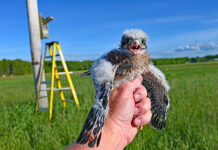Thanks to mild rainfall this spring, researchers are predicting a moderate harmful algal bloom in Lake Erie this summer, after a more severe bloom in 2019.
The National Oceanic and Atmospheric Administration announced July 9, in Ohio Sea Grant’s Lake Erie harmful algal bloom forecast webinar, that it expects the bloom to be about a 4.5 on the severity index, a scale of 1-10 where anything over five is considered critical. The bloom last year measured 7.3 on the index, on target with what researchers predicted for that year.
The index predicts the size of the bloom, but does not predict how toxic the bloom will be. A large bloom does not always equal a highly toxic bloom. Researchers are working on developing a way to forecast toxicity levels for algal blooms.
Harmful algal blooms are largely caused by nutrient runoff from land. The amount of phosphorus in the water influences bloom size, but nitrogen influences the toxicity.
While a wide range of groups have been working to reduce the amount of phosphorus going into the lake, researchers say that amount does not appear to be decreasing consistently. Researchers also noted, however, that this may just be because it takes time to see the results of some conservation practices.
Blooms
Rick Stumpf, an oceanographer with NOAA, said satellites show a low-intensity bloom started in the Maumee Bay in early July. It is not unusual for a bloom to start in July.
With a moderate bloom this year, much of the lake should be fine, Stumpf said. The wind, which is hard to predict, affects how long the bloom will last. Some areas might get scums on calm days. Stumpf emphasized that people and animals should stay out of scums they see in the lake.
He said that 2019 had a wet spring, which contributed to more runoff and a more severe bloom, while this year, the spring rainfall was milder.
Laura Johnson, director of the National Center for Water Quality Research at Heidelberg University, said the phosphorus load going into the lake this year appears to fall right in the middle when compared to recent years. While it looks moderate, however, it still exceeds the target load significantly.
This target is based on the U.S. and Canada’s goal, established in 2016 through the Great Lakes Water Quality Agreement, of reducing the total phosphorus going into the lake by 40% by 2025.
Trends
Since 2002, researchers have seen phosphorus loads vary from year to year. Overall, there has been no clear downward trend yet, Johnson said.
This doesn’t necessarily mean things aren’t headed in the right direction. Johnson said it can take time for practices implemented to decrease phosphorus runoff to start reducing the load.
Flow
The land itself isn’t the only factor. The amount of water flowing through streams is also important, and since the early 2000s, Johnson said, that amount is increasing overall, with more heavy rainfall in Ohio.
“The load over the past 20 years is really driven by flow,” Johnson said.
While no one can control the stream flow, which is affected by rainfall, people can work to influence the concentration of phosphorus in the water, Stumpf said.
Taking into account the stream flow, the concentration of phosphorus going into Lake Erie is relatively high this year, after several years of mostly consistent levels. Johnson said that because farmers were unable to plant in many of their fields last year, some of them may be doing more ground work this year to control weeds or improve soil conditions, leading to more runoff.
Runoff
Usually, Johnson said, over-applying phosphorus to land would cause more runoff. Much of the phosphorus runoff comes from agricultural land, but that can be due to commercial fertilizer, manure or even legacy phosphorus that has been in the fields for years, in some cases.
However, researchers aren’t seeing excessively high phosphorus application in most areas. So, she suggested, the issue might have more to do with where phosphorus is applied: on the surface or below the surface. While more farmers applying fertilizer below the surface could help, getting equipment to do that is expensive.
H2Ohio
The H2Ohio program, Gov. Mike DeWine’s water quality initiative, has been a major part of the conversation over the last year. Among other things, the program offers funding for farmers to implement better conservation practices. This funding opened to 14 counties in the Maumee River watershed this year.
This year, about 2,000 farmers signed up for the program, covering 43% of the cropland in the Maumee River Watershed. Kris Swartz, chair of the Ohio Agriculture Conservation Initiative and a Wood County farmer, said there are some counties where 50% of the cropland in the county is enrolled in the program.
“That’s just unheard of in the conservation world,” he said.
Swartz believes the program has gotten traction because it has been promoted by a range of groups, and can be used by farmers regardless of what they raise or grow and of whether they till or do not till.
But the COVID-19 pandemic has thrown a wrench into the program. The program, introduced in 2019, was originally funded with $172 million for two years through Ohio’s current budget. The pandemic created challenges for the state’s budget in many areas.
While the state managed to maintain funding for this year for H2Ohio’s agricultural program, it’s hard to know what will happen for the second year of funding.











